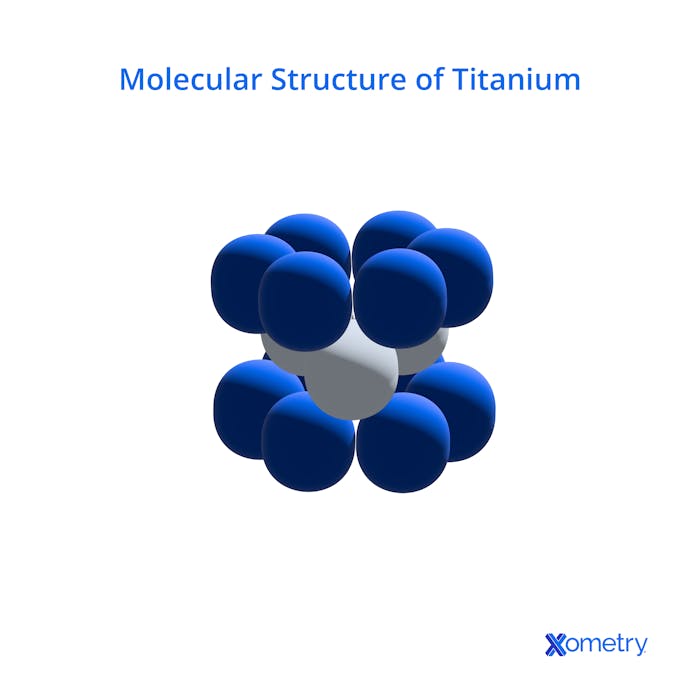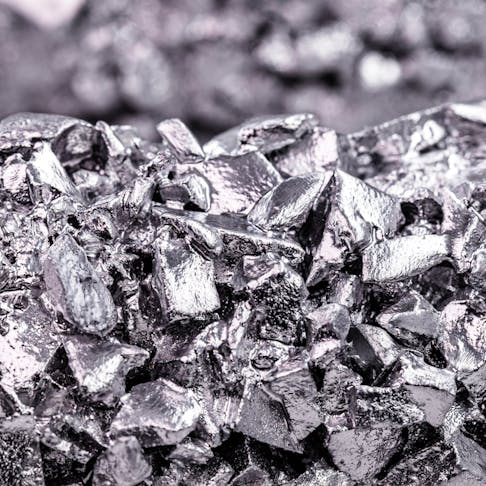Titanium has quite the reputation for being one of the strongest metals around. This “wonder metal” (yes, it also goes by that moniker) is used for many different applications in various industries, and it comes in different grades and alloys. At Xometry, we can instantly quote parts CNC machined or sheet cut titanium. Let’s learn more about titanium, how it’s made, and what it can do.
What Is Titanium?
Titanium is a metal that’s mainly known for its high strength, low weight, and corrosion resistance. It has the atomic number 22, and its chemical symbol on the periodic table is “Ti.” It has a silvery hue that typically leans toward either gray or white, but it can turn almost any color on the spectrum with different titanium anodizing methods by controlling the voltage during the process. Like most metals, titanium also has a shiny surface.
Titanium is Earth’s ninth most abundant element and can be found in igneous and sedimentary rocks, minerals, clay, and sand. However, you won’t be able to find titanium in its pure form in nature as it tends to react with oxygen. When it does, it creates a titanium dioxide (TiO₂) protective layer. Titanium is mainly extracted from two minerals—a dark brown to black rock with a crystal-like appearance called rutile, and ilmenite (titanium-iron oxide), a grayish-black rock. Other minerals that can also be refined to get pure titanium are anatase, perovskite, brookite, and titanite.
Although titanium doesn’t rank as one of the most expensive metals in the world, it is pricier than other common metals used in industry, like steel or aluminum. Pure titanium costs around $18 to $20 per kilo, and titanium alloys are usually priced anywhere from $70 to $80 per kilo.

A Brief History of Titanium
Titanium was first discovered as a mineral inclusion in 1791 in Cornwall, South West England, by a clergyman, geologist, and chemist called William Gregor. While out by a stream, Gregor found some black sand that was being pulled by a magnet. Upon closer inspection, he found iron oxide, and another whiter metal oxide that he didn’t recognize. He named the metal “manaccanite” and reported his discovery in French and German science journals.
He wasn’t the only one to stumble across this valuable metal and wonder what it was; Franz-Joseph Müller von Reichenstein, a mineralogist and mining engineer in Austria, was in a similar predicament. In 1795, a Prussian chemist, Martin Heinrich Klaproth, also happened upon this super strong element. He was the one who named it “titanium” — after the Titans of Greek mythology. It would take another 115 years until anyone managed to get pure titanium out.
In 1910, Matthew A. Hunter, a scientist from New Zealand working at the Rensselaer Polytechnic Institute in New York, isolated it by heating titanium tetrachloride (TiCl4) with sodium at high pressure and temperature (1292–1472°F). The result was pure titanium, and sodium chloride as a byproduct.
Then, in 1932, William Justin Kroll, a metallurgist from Luxembourg, found another way to isolate titanium, this time by reducing TiCl4 through fractional distillation with calcium, and later with magnesium and sodium. In the 1950s, the Soviet Union started using titanium for its military applications, including aviation and submarines, and it wasn’t long before the USA and other countries hopped on the titanium bandwagon.
Making Titanium
The “Kroll” and “Hunter” processes are still in use today for the commercial production of titanium, although Kroll is the most commonly used method. In the Kroll process, rutile or ilmenite is heated to get liquid TiCl4 which is then purified by fractional distillation processes, like the ones used to make gasoline from crude oil.
Molten magnesium is then added to the liquid TiCl4 which results in a porous, titanium “sponge” and a magnesium-based salt. After that, this sponge is compressed and melted in an arc furnace, and the pure titanium is cast into ingots. To make alloys, the pure titanium melt is mixed with other metals before the ingots step.
Properties and Features
Titanium is one of the strongest metals on the periodic table. It’s highly durable with a long expected life, thanks to its high tensile yield strength, hardness, and fatigue resistance. It’s versatile enough to be fabricated with many different machining methods, including forming, rolling, casting, and welding.
Its lower density (compared to many other metals) makes it impressively lightweight, and it has a high strength-to-weight ratio, too—more than aluminum, and it gives steel a run for its money. A titanium structure weighs around 45% less than a corresponding steel one as it has a lower density.
It won’t expand or contract as much as other materials (i.e., steel) in high temperatures, and it’s also bulletproof against handguns and hunting guns (although it will understandably struggle with high-powered, armor-piercing, military-grade weapons).

Classes and Grades
There are three classes of titanium—alpha-alloys, beta-alloys, and alpha-beta alloys—and various titanium-alloy grades that fall under these classes. Although there are around fifty different titanium alloy grades, ASTM International recognizes only 31 titanium metal and alloys in total, only four of which are actually pure. Each alloy type has different properties that make it more suitable for particular applications.
The list below describes the titanium classes and the grades that fall under them, along with their composition, features, and applications.
Alpha (α) Titanium
This class covers pure titanium and titanium alloys that are stabilized with elements like aluminum. They are super strong and ductile (although less so than other classes), formable, lightweight, corrosion resistant, and have high-temperature stability. Of the alpha class, Xometry offers Grade 2 titanium parts via CNC machining or sheet cutting.
Grade 1 pure titanium
- Composition: 99% titanium, 0.2% iron, 0.18% oxygen, and trace amounts of other elements such as nitrogen, carbon, and hydrogen
- Features: The softest, most ductile, and most formable of all the grades
- Applications: Plating, piping, tubing, automotive, power generation, aerospace
Grade 2 pure titanium
- Composition: 99% titanium, 0.3% iron, 0.25% oxygen, and trace amounts of other elements
- Features: Slightly stronger than Grade 1, more affordable than other grades as it’s more widely used and so produced in larger volumes
- Applications: Welding, anodizing, lining material, power generation, petroleum
Grade 3 pure titanium
- Composition: 99.2–99.7% titanium, with a maximum of 0.30% iron, 0.35% oxygen, 0.08% carbon, 0.05% nitrogen, and 0.015% hydrogen
- Features: Least commonly used pure titanium grade, stronger than Grades 1 and 2 but less ductile and formable
- Applications: Anodizing, cryogenic vessels, condenser tubing, pressure vessels, heat exchangers, piping systems, marine, chemical processing (pipes, flanges, tubing, tanks, pumps, heat exchangers)
Grade 4 pure titanium
- Composition: 98.9–99.5% titanium, with up to 0.50% iron, 0.40% oxygen, 0.08% carbon, 0.05% nitrogen, and 0.015% hydrogen
- Features: Strongest of all Alpha titanium alloys (comparable to stainless and low-carbon steel)
- Applications: Marine components (i.e., airframe structures and heat exchangers), industrial equipment (tanks, reactors, valves, pipes, connecting rods, pumps), surgical implants, aerospace, chemical processing, oil & gas
Beta (β) Titanium
The beta class includes titanium alloys that are stabilized with elements like vanadium or molybdenum. These, too, are corrosion-resistant, workable, and have a high strength-to-weight ratio. They also have better ductility and formability than alphas.
Grade 7
- Composition: 99% titanium, 0.12-0.25% palladium, 0.3% iron, 0.25% oxygen, and other elements
- Features: Highest corrosion resistance of all titanium alloys, can withstand harsh environments, nearly identical to Grade 2
- Applications: Welding, forming, desalination, chemical manufacturing
Grade 11
- Composition: 99.75% titanium, and 0.25% palladium
- Features: Corrosion resistance (particularly in acidic environments), similar to Grades 1 and 2, crevice corrosion resistance, highly ductile, impact toughness
- Applications: Welding, chemical processing and storage, ducts, pumps, and heat exchangers
Grade 12 (Ti-0.3Mo-0.8Ni)
- Composition: 99% titanium, 0.6-0.9% nickel, 0.2-0.4% molybdenum, up to 0.3% iron, up to 0.25% oxygen, and other elements
- Features: Strong, corrosion resistant (particularly in reducing acids), durable, thermally stable
- Applications: Welding, forming, marine components (ships, offshore drilling platforms), chemical manufacturing, and heat exchangers
Alpha-Beta (α-β) Titanium
These alloys combine features of both alpha and beta types. They’re strong, ductile, corrosion resistant, and can withstand high temperatures. Of these, Xometry regularly provides quotes on CNC or sheet cut parts made of Grade 5 titanium.
Grade 5 (Ti-6Al-4V)
- Composition: 88-90% titanium, 5.5-6.75% aluminum, 3.5-4.5% vanadium, and trace amounts of other elements (iron, oxygen, carbon, and hydrogen)
- Features: The most commonly used titanium alloy (accounts for half of all the titanium used in the world), high strength, good ductility, heat resistant, can be heat treated, formabile, corrosion resistant
- Applications: Engines and structural components in aerospace (landing gear, firewalls, hydraulic systems, etc.), automotive parts (engine parts, crankshafts, valve seats, connecting rods, exhausts, suspension, frames, springs), medical (i.e., joint implants), sporting goods, consumer products, 3D printing
Grade 6 (Ti-5Al-2.5Sn)
- Composition: 92% titanium, 5% aluminum, 2.5% tin, and 0.5% iron
- Features: Strength, ductility, creep resistance, temperature stability, suitable for higher service temperatures of 900°F
- Applications: Casings/rings in turbine engines, structural members/frames in aerospace, and chemical processing parts
Grade 23 (Ti-6Al-4V ELI)
- Composition: 88-90% titanium, 5.5-6.5% aluminum, 3.5-4.5% vanadium, 0.25% iron, 0.13% oxygen, and other elements
- Features: Similar to Grade 5 but more pure, ductile, and tough, has high tensile and yield strength, high weldability
- Applications: Aerospace, dental (tooth implants), medical (implants, bone and joint replacements, surgical staples, ligature clips
Grade of Titanium Used for 3D Printing
Grade 5 (Ti 6Al-4V) titanium is the one used for 3D printing. Grade 5 is best for 3D printing because of its high strength, excellent formability, and thermal stability. Powder bed fusion 3D printing methods like selective laser melting, electron beam melting, and direct metal laser sintering are used to 3D print titanium. These processes consist of selectively melting titanium powder that has been precisely laid onto a print bed. A powerful laser or electron beam melts the titanium powder and fuses it with the preceding layers of printed material to build completed parts.
Limitations
Despite raving about all of titanium’s perks, it’s worth having a look at a few things this metal is not so good at. For starters, it can be reactive at high temperatures of over 700°F—something that makes the fabrication rather tedious and highly controlled. Production of titanium has to be in a carefully controlled and oxygen-free environment.
While its low thermal conductivity does have its benefits, it can lead to the heat generated during manufacturing to build up in the tool rather than the material—not great news for the tool’s lifespan and quality. In addition, at temperatures above 570°F, titanium has low creep resistance (the slow deformation of a material when constantly under heavy loads). Finally, refining raw rocks and minerals to get pure titanium is not a cheap, easy, or quick endeavor.
Titanium Applications
Titanium is used in everything from condensers in power plants and desalination plants to consumer goods like golf clubs and bicycle frames. Our aerospace and automotive customers heavily rely on titanium, as it often finds itself useful in their projects.
In aerospace, it accounts for nearly 50% of an aircraft’s total weight and it's so valuable in the industry that it’s even sometimes referred to as “aerospace metal.” For automakers, titanium’s characteristics can create parts with better aerodynamics and performance. Its low density and high strength also make it a more cost-effective manufacturing process since less material is needed.
We’ve already covered the titanium grades most commonly used in different industries above (such as industrial, chemical processing, and marine), but here are a few more ways titanium is widely being used around the world today.
- Jewelry: Used to make piercings, watches, necklaces, rings, and other jewelry items. Sometimes mixed with gold to make 24-karat gold alloys which are harder and more durable than pure gold alternatives. Its biocompatibility also makes titanium a popular go-to for people allergic to other metals, like nickel.
- Medical: Used in surgical and dental tools, implants, joint replacements, and osseointegration for better patient outcomes and implants/prosthetics that can last up to 30 years.
- Architectural: While steel is still the preferred metal for building frames, titanium is often used for glass frames, facades, roofs, interior wall surfaces, and ceilings thanks to its corrosion resistance and high strength-to-weight ratio.
- Composites: Titanium-based composites are recently developed materials used to make titanium fiber-reinforced or powder-reinforced composites. These have higher stiffness, wear resistance, and strength than conventional alloys. Although fairly new, titanium composites are starting to make their way to the aerospace and automotive industries.
- 3D Printing: Grade 5 titanium is used in 3D printing with powder bed fusion 3D printing methods, like direct metal laser sintering (a service we offer here at Xometry), selective laser melting, and electron beam melting. To build strong 3D printed parts, titanium powder is laid onto the printer’s bed and then the machine’s laser/electron beam fuses the particles together in cross sections of the parts design, layer by layer.
How Xometry Can Help
Xometry makes quoting custom titanium parts easy for CNC machining, sheet cutting, laser cutting, and even sheet metal services. You’ll find Grade 2 and 5 titanium right on our menu, but we can source and work from other grades upon request. You can get started by heading over to Xometrys Instant Quoting Engine® and uploading your files to get a quote.
Disclaimer
The content appearing on this webpage is for informational purposes only. Xometry makes no representation or warranty of any kind, be it expressed or implied, as to the accuracy, completeness, or validity of the information. Any performance parameters, geometric tolerances, specific design features, quality and types of materials, or processes should not be inferred to represent what will be delivered by third-party suppliers or manufacturers through Xometry’s network. Buyers seeking quotes for parts are responsible for defining the specific requirements for those parts. Please refer to our terms and conditions for more information.


